Energy Refurbishment of an Office Building with Hybrid Photovoltaic System and Demand-Side Management
Abstract
1. Introduction
2. Methodology
2.1. Reference Office Building and Weather Conditions
2.2. Modeling Office Building
2.2.1. Building Operation
2.2.2. Lighting System
- In each perimeter zones, which do not receive daylight, electric lights levels are reduced if the electric illuminance is greater than 700 Lux, according to the Spanish building code (500 Lux–1000 Lux) [22];
- If the daylight illuminance is less than 700 Lux, electric light levels are controlled in order to achieve the set point illuminance of 700 Lux [7];
- Electric lights are completely shut down if daylight illuminance exceeds 700 Lux.
2.2.3. HVAC System and Hot Water
2.3. On-site Photovoltaic Hybrid System
2.4. Energy Management with BESS
- Peak shaving: In this strategy, the battery comes into operation only to supply load powers that surpass a predetermined maximum power limit (Pmax). The limit Pmax is applied with the aim of reducing grid power peaks and eventually, the nominal grid connection capacity () and the associated electricity bill capacity charges, although Pmax and are not necessarily equivalents.
- Energy cutback: Here, the main purpose is to reduce electricity imports and, therefore, the electricity bill energy charges. Note that this case is equivalent to the previous strategy with Pmax = 0, allowing the battery to discharge when PPV < PLoad and SoC > SoCmin. If the SoCmax is reached, the PV surplus is fed into the grid. The equations of the BESS and the grid power flows (PGrid) can be seen in Figure 5.
2.5. Load Matching and Capacity Factor
2.6. Economic Assessment
3. Results
3.1. Building End-Use Loads Consumption and PV Generation
3.2. Demand-side Management with BESS
3.3. Load Matching and Grid Interaction
3.4. Photovoltaic Hybrid System Economic Analysis
3.4.1. Economic Assessment without BESS
3.4.2. Economic Assessment with BESS
4. Conclusions
Acknowledgments
Author Contributions
Conflicts of Interest
Appendix A

References
- European Commission—Eurostat Unit ESTAT 5: Electricity Consumption by Industry, Transport Activities and Households/Services. Energy L-2920. Luxembourg. Available online: http://ec.europa.eu/eurostat (accessed on 26 July 2017).
- Fasi, M.A.; Budaiwi, I.M. Energy performance of windows in office buildings considering daylight integration and visual comfort in hot climates. Energy Build. 2015, 108, 307–316. [Google Scholar] [CrossRef]
- Cao, S.; Hasan, A.; Sirén, K. Matching analysis for on-site hybrid renewable energy systems of office buildings with extended indices. Appl. Energy 2014, 113, 230–247. [Google Scholar] [CrossRef]
- International Energy Agency (IEA); Photovoltaic Power Systems Programme (PVPS). Review and Analysis of Self-Consumption Policies; International Energy Agency (IEA): Paris, France, 2016. [Google Scholar]
- Strbac, G. Demand side management: Benefits and challenges. Energy Policy 2008, 36, 4419–4426. [Google Scholar] [CrossRef]
- Staats, M.R.; de Boer-Meulman, P.D.M.; Van Sark, W.G.J.H.M. Experimental determination of demand side management potential of wet appliances in the Netherlands. Sustain. Energy Grid Netw. 2017, 9, 80–94. [Google Scholar] [CrossRef]
- Sehar, F.; Pipattanasomporn, M.; Rahman, S. An energy management model to study energy and peak power savings from PV and storage in demand responsive buildings. Appl. Energy 2016, 173, 406–417. [Google Scholar] [CrossRef]
- Ratnam, E.L.; Weller, S.R.; Kellett, C.M. Scheduling residential battery storage with solar PV: Assessing the benefits of net metering. Appl. Energy 2015, 155, 881–891. [Google Scholar] [CrossRef]
- Oliveira e Silva, G.; Hendrick, P. Lead–acid batteries coupled with photovoltaics for increased electricity self-sufficiency in households. Appl. Energy 2016, 178, 856–867. [Google Scholar] [CrossRef]
- Balcombe, P.; Rigby, D.; Azapagic, A. Energy self-sufficiency, grid demand variability and consumer costs: Integrating solar PV, Stirling engine CHP and battery storage. Appl. Energy 2015, 155, 393–408. [Google Scholar] [CrossRef]
- Luthander, R.; Widén, J.; Nilsson, D.; Palm, J. Photovoltaic self-consumption in buildings: A review. Appl. Energy 2015, 142, 80–94. [Google Scholar] [CrossRef]
- World Energy Resources Report 2016: E-storage: Shifting from Cost to Value Wind and Solar Applications; World Energy Council: London, UK, 2016.
- Briano, J.I.; Pardo, I.P.; García, M.V. PV Grid Parity Monitor: Commercial Sector 3rd Issue; Creara: Madrid, Spain, 2016. [Google Scholar]
- Agência Nacional de Energia Elétrica (ANEEL). Resolução Aneel n° 687. 2015. Available online: www.aneel.gov.br/cedoc/ren2015687.pdf (accessed on 26 July 2017).
- Ministry of Industry, Energy and Tourism Royal Decree 900. Boletín Oficial del Estado. Number 243. Spain, 10 October 2015; p. 94874. Available online: https://www.boe.es/boe/dias/2015/10/10/pdfs/BOE-A-2015-10927.pdf (accessed on 26 July 2017).
- Lopes, R.A.; Martins, J.; Aelenei, D.; Lima, C.P. A cooperative net zero energy community to improve load matching. Renew. Energy 2016, 93, 1–13. [Google Scholar] [CrossRef]
- Dávi, G.A.; Caamaño-Martín, E.; Rüther, R.; Solano, J. Energy performance evaluation of a net plus-energy residential building with grid-connected photovoltaic system in Brazil. Energy Build. 2016, 120, 19–29. [Google Scholar] [CrossRef]
- Salom, J.; Marszal, A.J.; Widén, J.; Candanedo, J.; Lindberg, K.B. Analysis of load match and grid interaction indicators in net zero energy buildings with simulated and monitored data. Appl. Energy 2014, 136, 119–131. [Google Scholar] [CrossRef]
- Salom, J.; Widén, J.; Candanedo, J.; Sartori, I.; Voss, K.; Marszal, A. Understanding net zero energy buildings: Evaluation of load matching and grid interaction indicators. In Proceedings of the 12th Conference of International Building Performance Simulation, Sydney, Australia, 14–16 November 2011. [Google Scholar]
- Weniger, J.; Tjaden, T.; Quaschning, V. Sizing of Residential PV Battery Systems. Energy Procedia 2014, 46, 78–87. [Google Scholar] [CrossRef]
- Cucchiella, F.; D’Adamo, I.; Gastaldi, M. A profitability assessment of small-scale photovoltaic systems in an electricity market without subsidies. Energy Conver. Manag. 2016, 129, 62–74. [Google Scholar] [CrossRef]
- Miller, N.; Manz, D.; Roedel, J.; Marken, P.; Kronbeck, E. Utility scale Battery Energy Storage Systems. In Proceedings of the Power and Energy Society General Meeting, Providence, RI, USA, 25–29 July 2010. [Google Scholar]
- Isa, N.M.; Das, H.S.; Tan, C.W.; Yatim, A.H.M.; Lau, K.Y. A techno-economic assessment of a combined heat and power photovoltaic/fuel cell/battery energy system in Malaysia hospital. Energy 2016, 112, 75–90. [Google Scholar] [CrossRef]
- Merei, G.; Moshövel, J.; Magnor, D.; Sauer, D.U. Optimization of self-consumption and techno-economic analysis of PV-battery systems in commercial applications. Appl. Energy 2016, 168, 171–178. [Google Scholar] [CrossRef]
- Orioli, A.; Di Gangi, A. Six-years-long effects of the Italian policies for photovoltaics on the grid parity of grid-connected photovoltaic systems installed in urban contexts. Energy 2017, 130, 55–75. [Google Scholar] [CrossRef]
- Thygesen, R.; Karlsson, B. Simulation and analysis of a solar assisted heat pump system with two different storage types for high levels of PV electricity self-consumption. Sol. Energy 2014, 103, 19–27. [Google Scholar] [CrossRef]
- Jayasekara, N.; Wolfs, P.; Masoum, M.A.S. An optimal management strategy for distributed storages in distribution networks with high penetrations of PV. Electr. Power Syst. Res. 2014, 116, 147–157. [Google Scholar] [CrossRef]
- European Union Directive 2010/31/EU of the European Parliament and of the Council of 19 May 2010 on the Energy Performance of Buildings. Available online: http://eur-lex.europa.eu/legal-content/EN/TXT/?uri=CELEX%3A32010L0031 (accessed on 26 July 2017).
- Ferrari, S.; Beccali, M. Energy-environmental and cost assessment of a set of strategies for retrofitting a public building toward nearly zero-energy building target. Sustain. Cities Soc. 2017, 32, 226–234. [Google Scholar] [CrossRef]
- Österreicher, D.; Geissler, S. Refurbishment in Educational Buildings—Methodological Approach for High Performance Integrated School Refurbishment Actions. Energy Procedia 2016, 96, 375–385. [Google Scholar] [CrossRef]
- Ascione, F.; Bianco, N.; De Masi, R.F.; Mauro, G.M.; Vanoli, G.P. Energy retrofit of educational buildings: Transient energy simulations, model calibration and multi-objective optimization towards nearly zero-energy performance. Energy Build. 2017, 144, 303–319. [Google Scholar] [CrossRef]
- Bánóczy, E.; Szemes, P.T. Simulation-based optimization in energy efficiency retrofit for office building. In Proceedings of the 2014 IEEE/SICE International Symposium on System Integration (SII), Tokyo, Japan, 13–15 December 2014. [Google Scholar]
- Marszal, A.J.; Heiselberg, P.; Bourrelle, J.S.; Musall, E.; Voss, K.; Sartori, I.; Napolitano, A. Zero Energy Building—A review of definitions and calculation methodologies. Energy Build. 2011, 43, 971–979. [Google Scholar] [CrossRef]
- Instituto Para La Diversificación y Ahorro de la Energía (IDAE). Código técnico de la Edificación (CTE). Documento Básico HE: Ahorro de Energía. 2013. Available online: http://www.codigotecnico.org/images/stories/pdf/ahorroEnergia/DBHE.pdf (accessed on 26 July 2017).
- Wang, L.; Gwilliam, J.; Jones, P. Case study of zero energy house design in UK. Energy Build. 2009, 41, 1215–1222. [Google Scholar] [CrossRef]
- Cuce, E.; Cuce, P.M.; Wood, C.J.; Riffat, S.B. Optimizing insulation thickness and analysing environmental impacts of aerogel-based thermal superinsulation in buildings. Energy Build. 2014, 77, 28–39. [Google Scholar] [CrossRef]
- Kottek, M. World map of the Köppen-Geiger climate classification updated. Meteorel. Z. 2006, 15, 259–263. [Google Scholar] [CrossRef]
- Weather Analytics. Available online: http://www.weatheranalytics.com/wa (accessed on 26 July 2017).
- EnergyPlus Engineering Reference. The Reference to EnergyPlus Calculations in EnergyPlus Version 8.3. Lawrence Berkeley National Laboratory: Berkely, CA, USA. Available online: https://energyplus.net (accessed on 26 July 2017).
- Scognamiglio, A.; Rostvik, H. hotovoltaics and zero energy buildings: A new opportunity and challenge for design. In Proceedings of the 27th EU PVSEC, Frankfurt, Germany, 24–28 September 2012. [Google Scholar]
- Li, Y.; Rezgui, Y. A novel concept to measure envelope thermal transmittance and air infiltration using a combined simulation and experimental approach. Energy Build. 2017, 140, 380–387. [Google Scholar] [CrossRef]
- Ahn, B.; Jang, C.; Leigh, S.; Yoo, S.; Jeong, H. Effect of LED lighting on the cooling and heating loads in office buildings. Appl. Energy 2014, 113, 1484–1489. [Google Scholar] [CrossRef]
- EnergyPlus Input-Output Reference. Reference for Input-Output Data in EnergyPlus Version 8.3. Lawrence Berkeley National Laboratory: Berkely, CA, USA. Available online: https://energyplus.net (accessed on 26 July 2017).
- European Committee for Standardization (CEN). Indoor Environmental Input Parameters for Design and Assessment of Energy Performance of Buildings Addressing Indoor Air Quality, Thermal Environment, Lighting and Acoustics; EN 15251:2007; European Committee for Standardization (CEN): Brussels, Belgium, 2007. [Google Scholar]
- Castillo-Cagigal, M.; Caamaño-Martín, E.; Matallanas, E.; Masa-Bote, D.; Gutiérrez, A.; Monasterio-Huelin, F.; Jiménez-Leube, J. PV self-consumption optimization with storage and Active DSM for the residential sector. Sol. Energy 2011, 85, 2338–2348. [Google Scholar] [CrossRef]
- Schiffer, J.; Sauer, D.U.; Bindner, H.; Cronin, T.; Lundsager, P.; Kaiser, R. Model prediction for ranking lead-acid batteries according to expected lifetime in renewable energy systems and autonomous power-supply systems. J. Power Sources 2007, 168, 66–78. [Google Scholar] [CrossRef]
- Schmidt, H.; Sauer, D.U. Praxisgerechte und praezise Modellierung von Wechselrichter-Wirkungsgraden. In Proceedings of the IX International Solar Forum, Stuttgart, Germany, 1997. [Google Scholar]
- Verbruggen, B.; De Coninck, R.; Baetens, R.; Saelens, D.; Helsen, L.; Driesen, J. Grid impact indicators for active building simulation. In Proceedings of the 2011 IEEE PES Innovative Smart Grid Technologies (ISGT), Anaheim, CA, USA, 17–19 January 2011. [Google Scholar]
- Jordan, D.C.; Kurtz, S.R. Photovoltaic Degradation Rates: An Analytical Review. Prog. Photovolt. Res. Appl. 2013, 21, 12–29. [Google Scholar] [CrossRef]
- International Energy Agency (IEA); Photovoltaic Power Systems Programme (PVPS). Trends 2016 in Photovoltaic Applications; International Energy Agency (IEA): Paris, France, 2016. [Google Scholar]
- Techno Sun. Available online: http://www.technosun.com/es/index.php (accessed on 26 July 2017).
- Red Eléctrica de España Sistema de información del operador del sistema. Available online: http://www.esios.ree.es (accessed on 26 July 2017).
- Aragonés, V.; Barquín, J.; Alba, J. The New Spanish Self-consumption Regulation. Energy Procedia 2016, 106, 245–257. [Google Scholar] [CrossRef]
- Berrada, A.; Loudiyi, K.; Zorkani, I. Valuation of energy storage in energy and regulation markets. Energy 2016, 115, 1109–1118. [Google Scholar] [CrossRef]

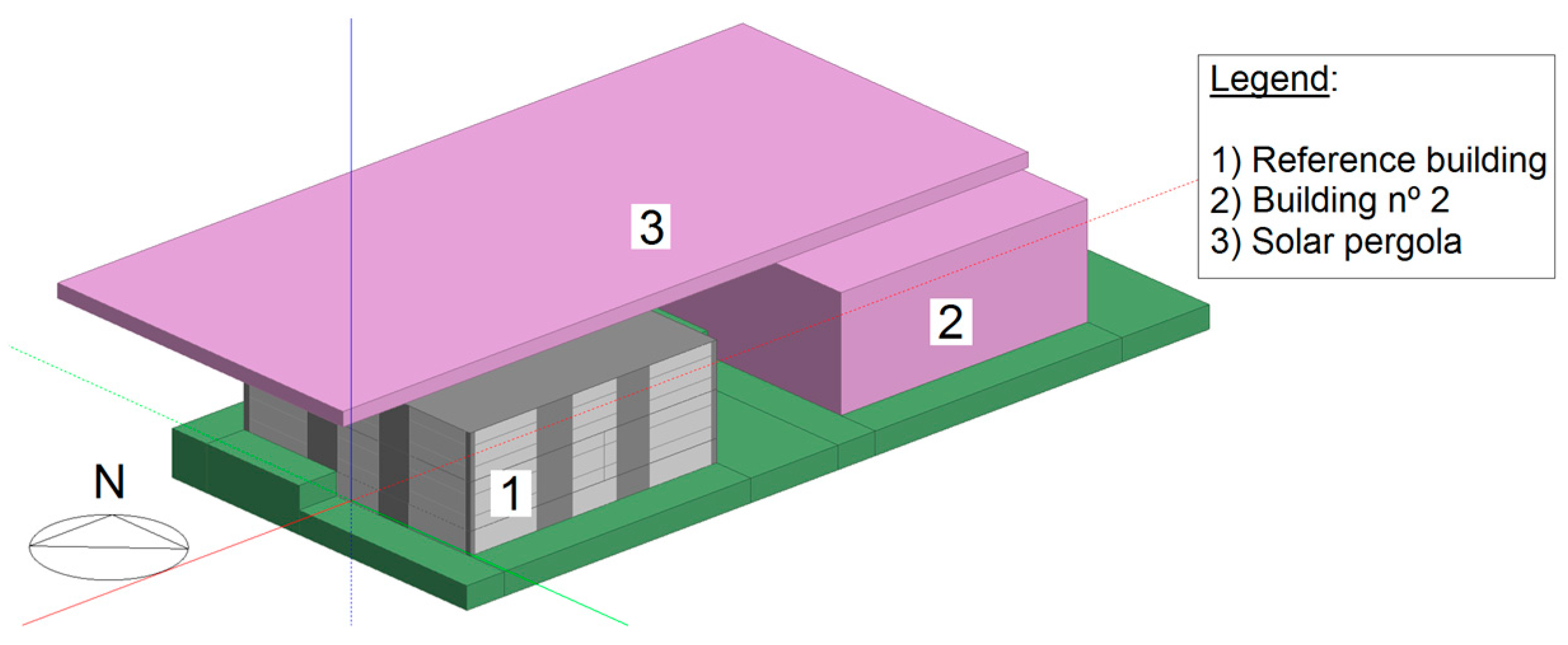

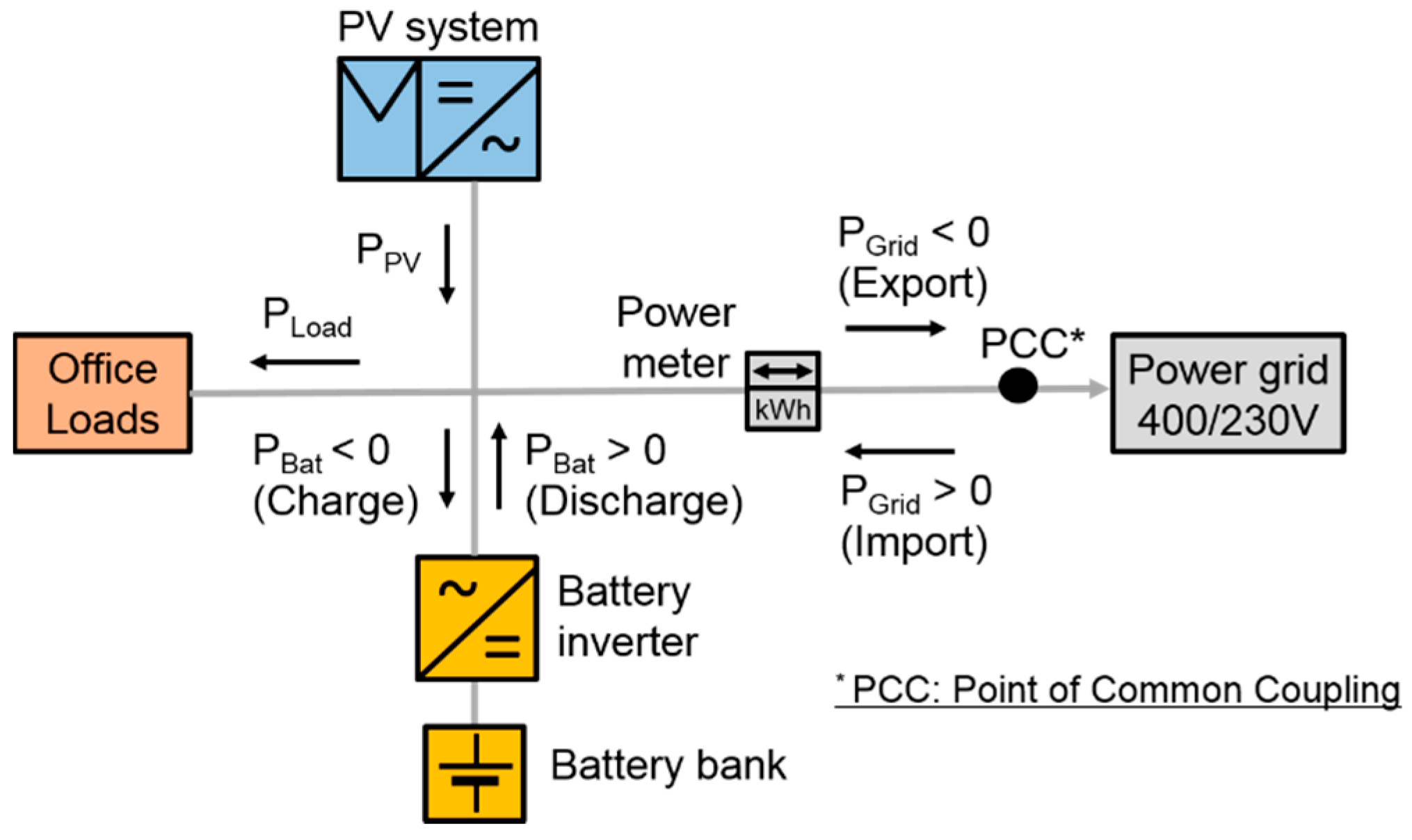
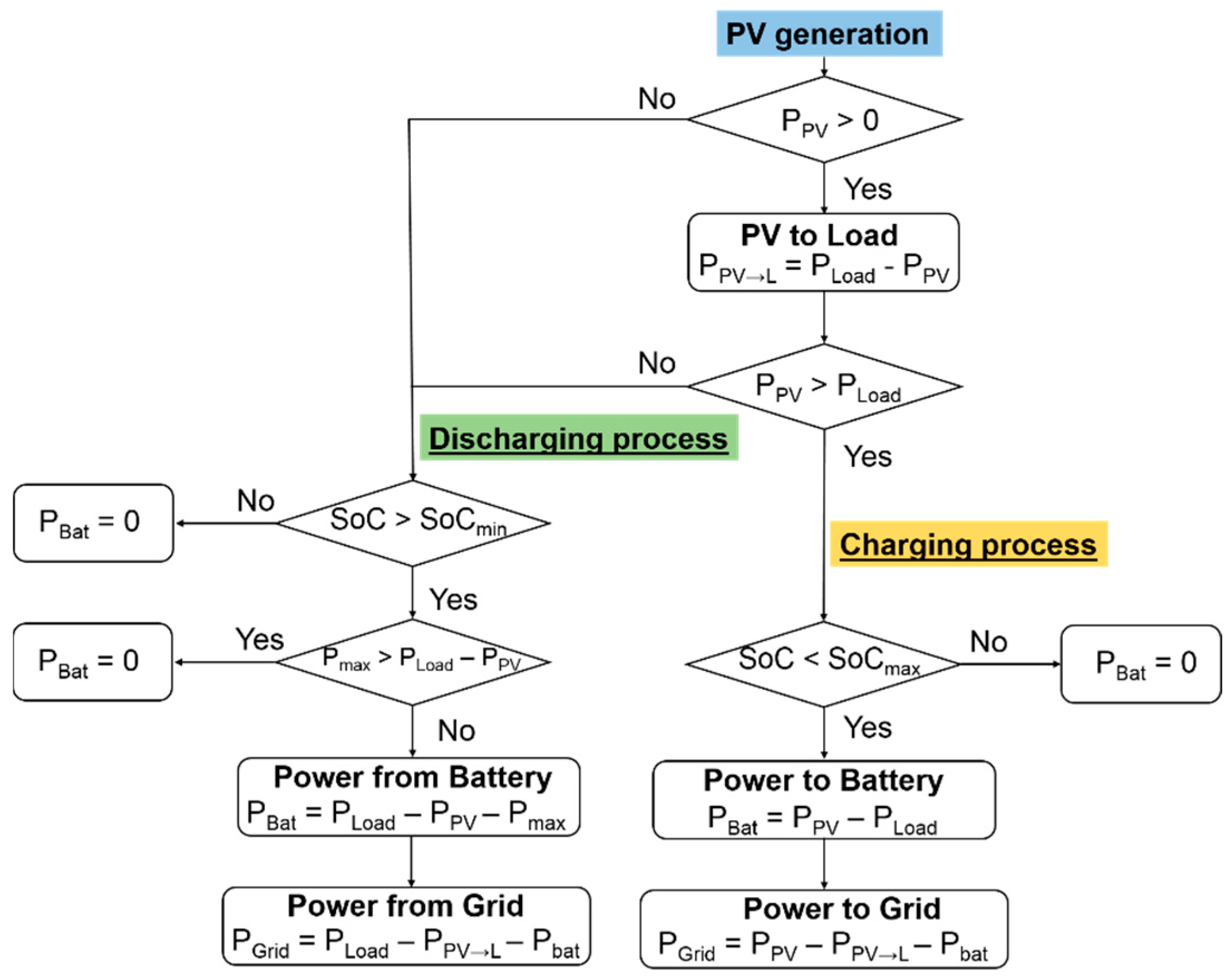



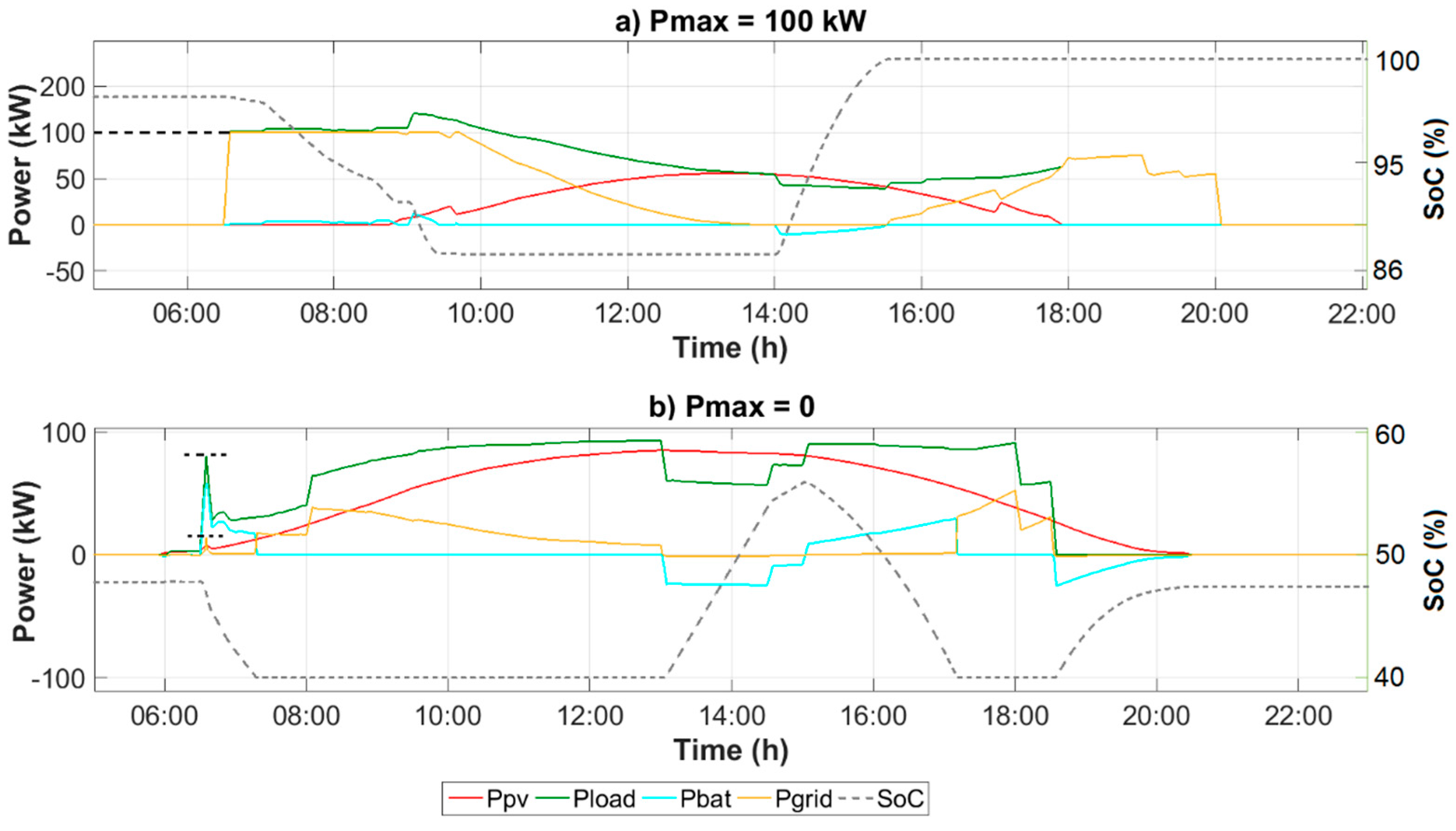
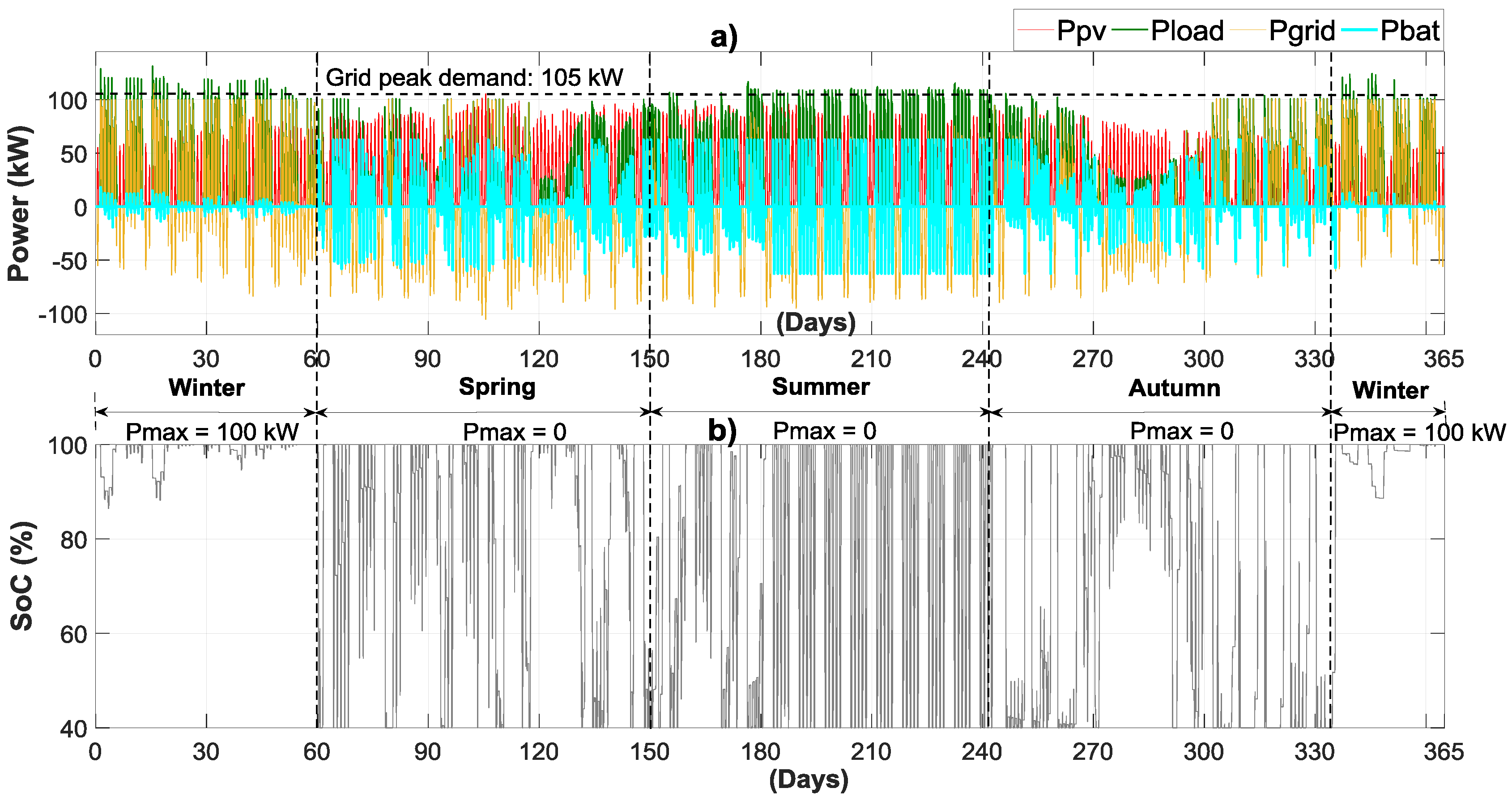
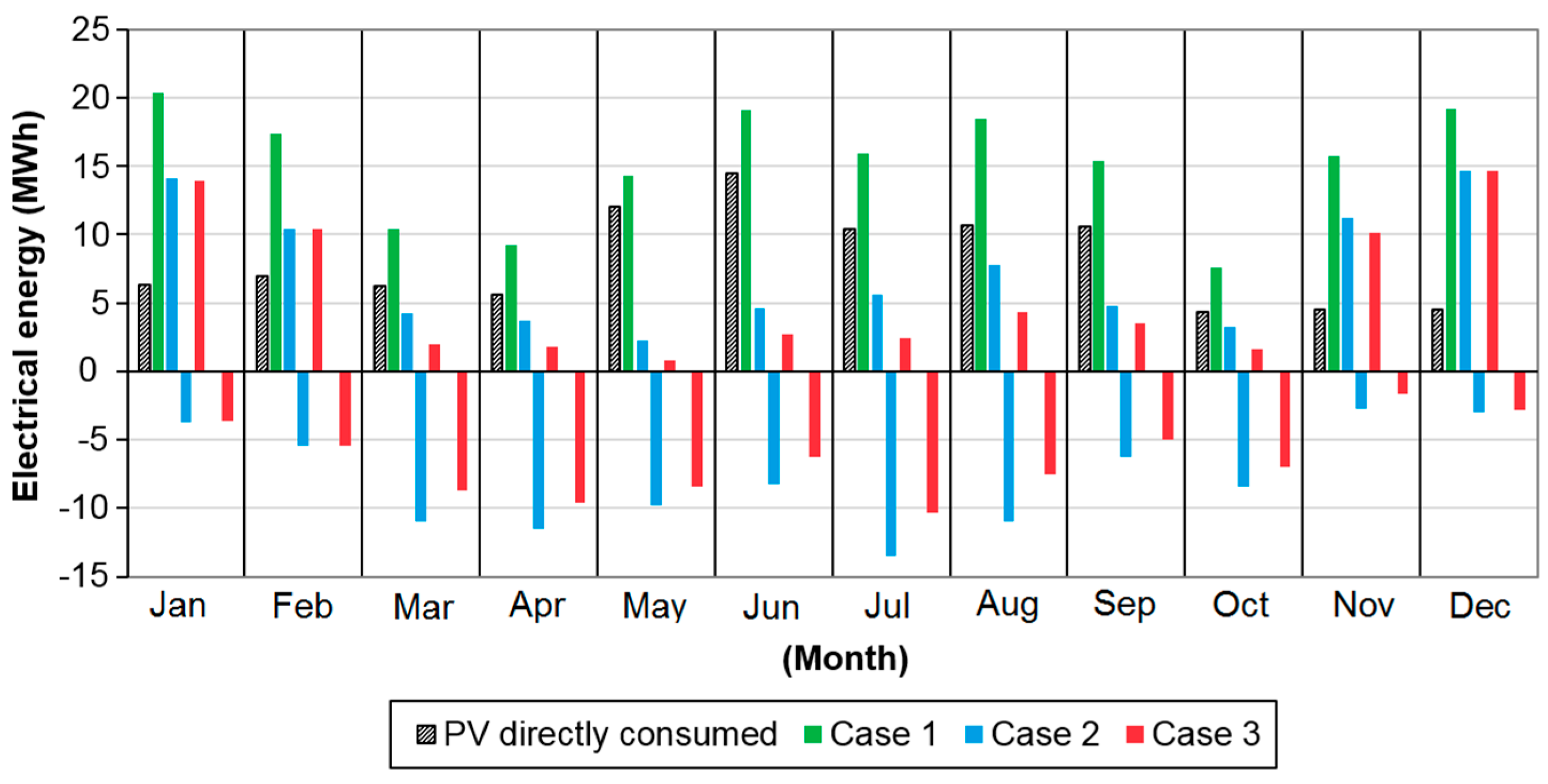
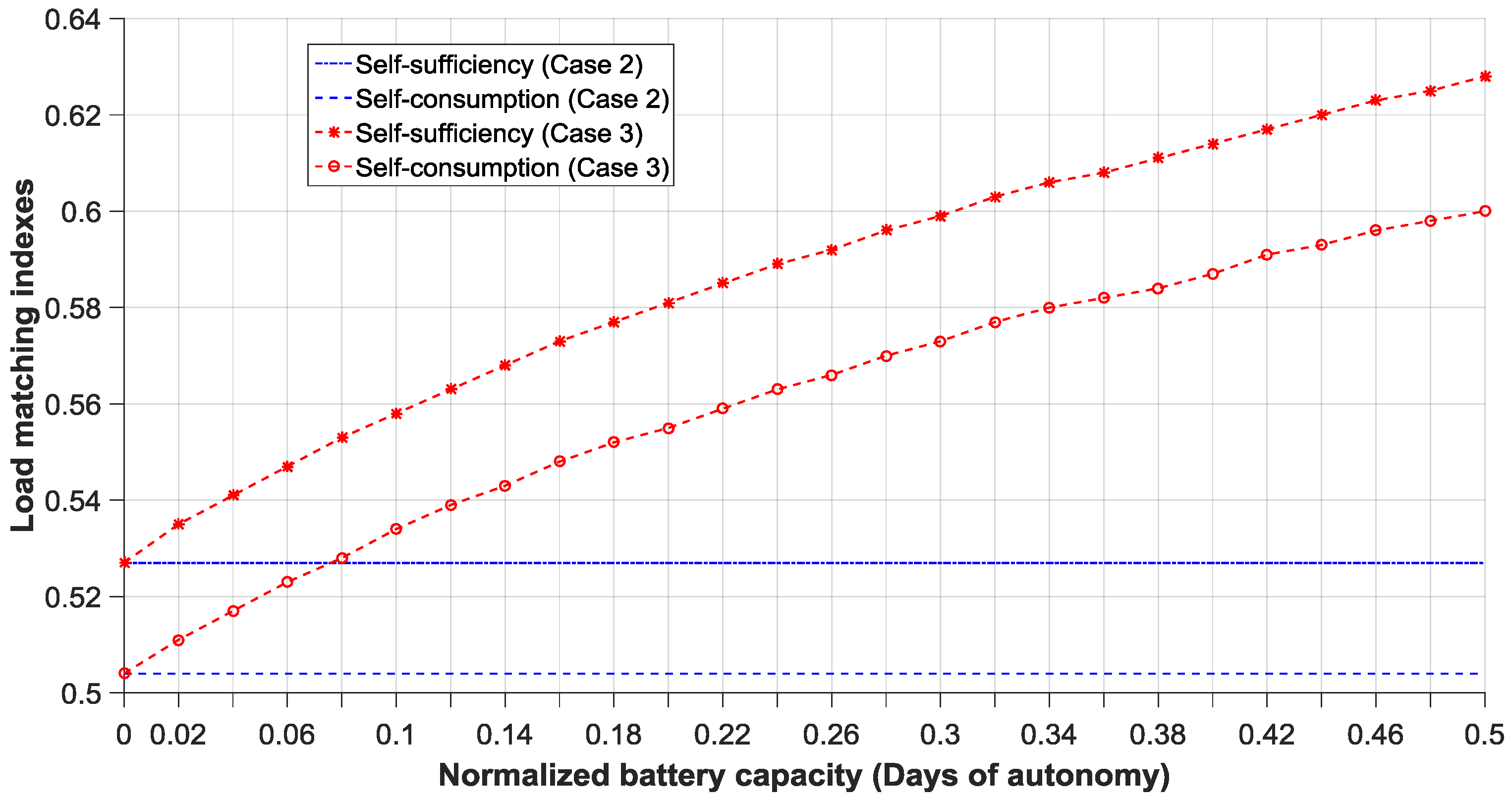
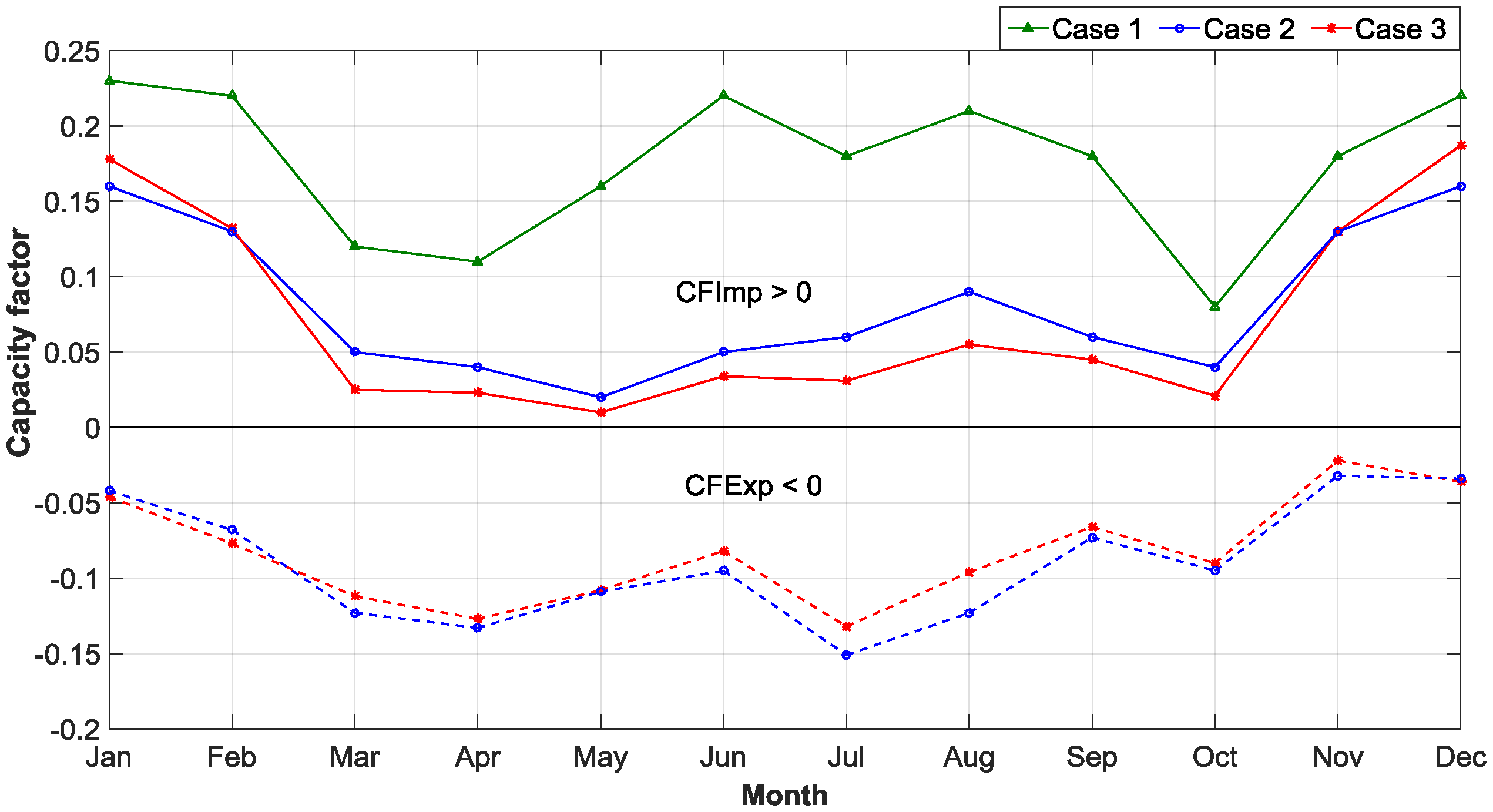
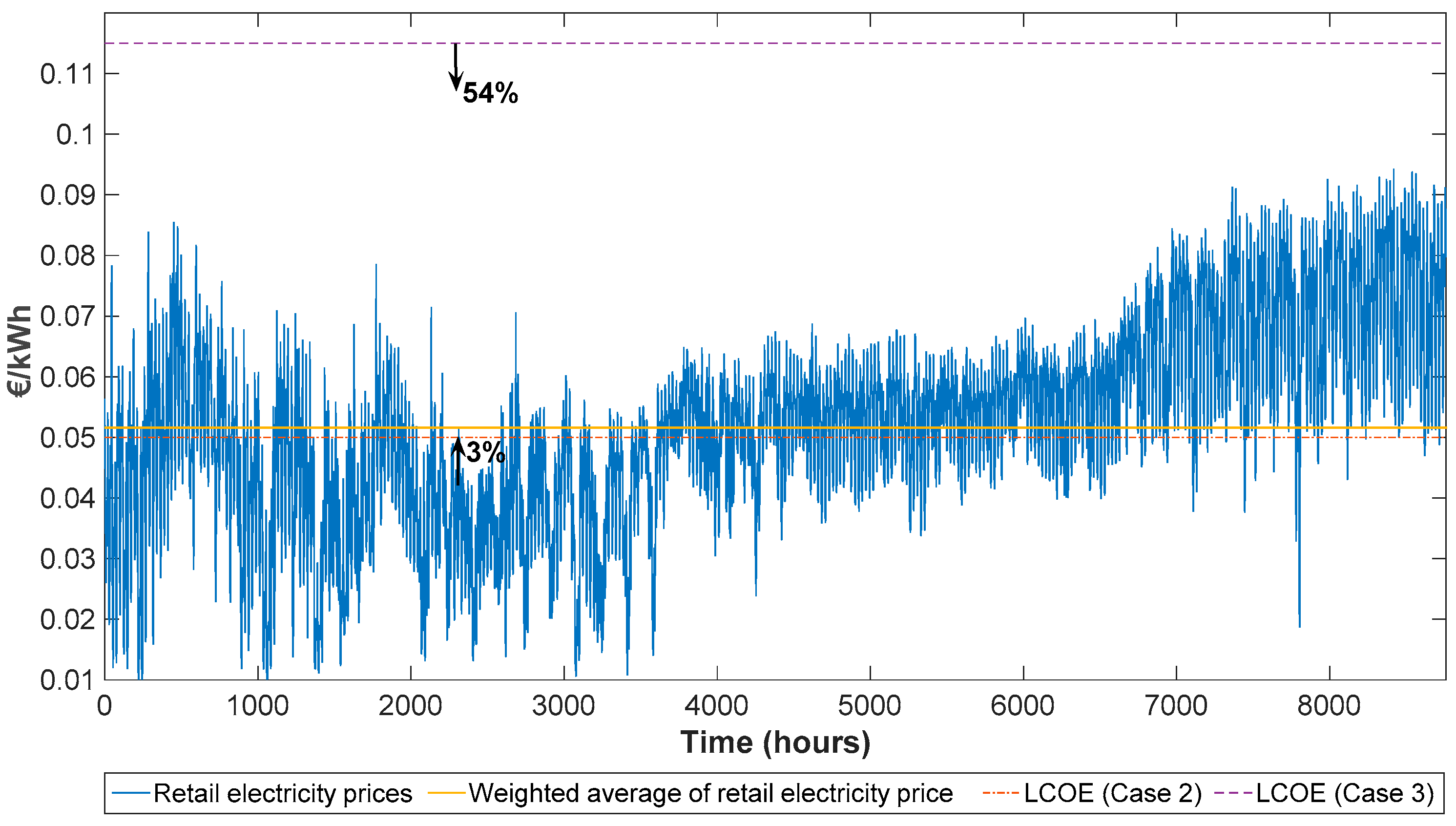
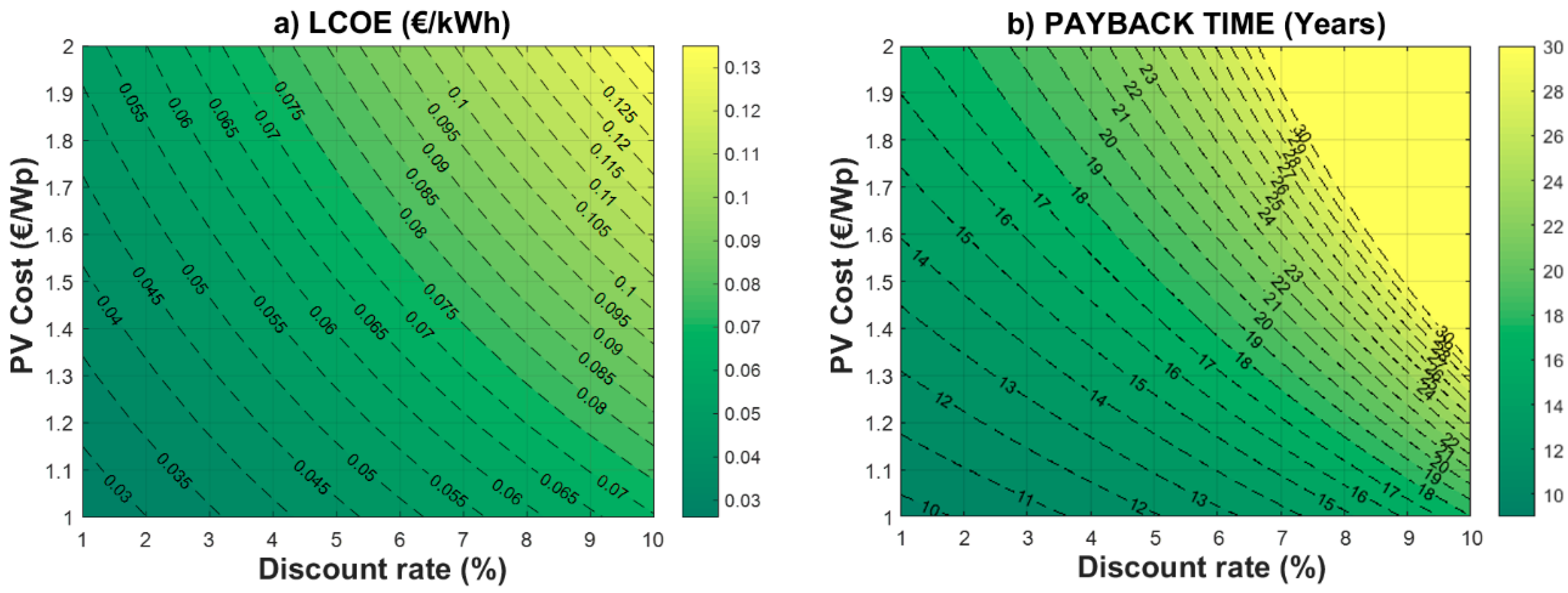
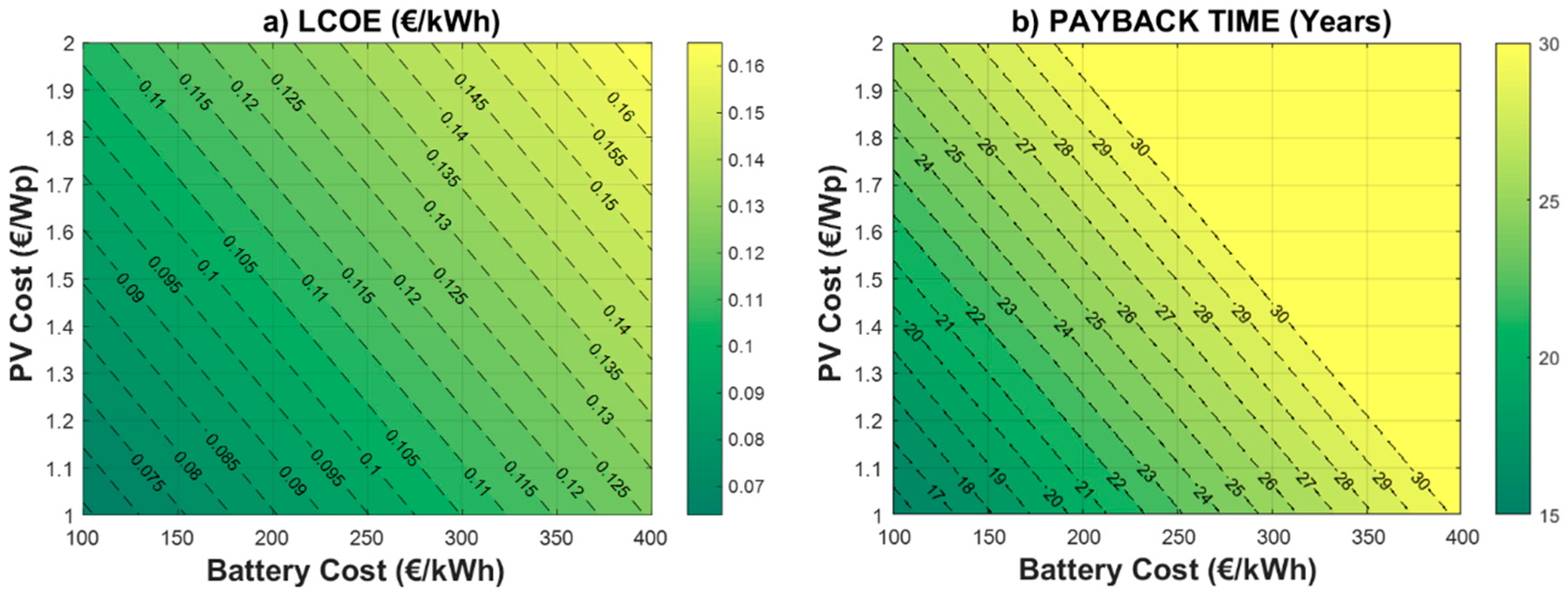
| Component | Building Envelope Characteristics |
|---|---|
| External Walls U = 0.49 W/m2 K | 0.02 m Plasterboard (900 kg/m3, 0.25 W/m K), 0.06 m MW Glass wool (40 kg/m3, 0.04 W/m K), 0.1 m Air gap (1000 kg/m3, 0.026 W/m K), 0.12 m Precast concrete planks (1700 kg/m3) |
| Ground floor U = 0.96 W/m2 K | 0.03 m Wood board (480 kg/m3, 0.15 W/m K), 0.05 m Air gap, 0.25 m Precast concrete planks (1580 kg/m3, 1.56 W/m K), 0.1 m Air gap |
| Roof and ceiling U = 0.31 W/m2 K | 0.02 m Plasterboard, 0.1 m Air gap, 0.25 m Precast concrete planks, 0.1 m Leveling mortar (1000 kg/m3, 0.41 W/m K), 0.002 m Bituminous membrane, 0.08 m XPS extruded polystyrene (38 kg/m3, 0.032W/m K), 0.1 m Gravel (1450 kg/m3, 2.0 W/m K) |
| Glazing U = 2.71 W/m2 K | 0.006 m SGG Parsol, 0.012 m Air gap, 0.006 m SGG Planilux, SHGC = 0.05 |
| Case | Building Energy Refurbishment |
|---|---|
| 1 | LED dimming control: the building electricity demand is modified by means of the reduction of LED power requirements, LED heating properties and LED dimming control, according to the daylighting illuminance that reaches the indoor environment. Renewable energy sources are not considered in the analysis. |
| 2 | LED dimming control + Roof-integrated PV system (solar pergola): In addition to lighting performance, the solar pergola affects the air conditioning electrical consumption by providing shadowing on the roof and on the curtain walls. The PV system provides local electricity to supply directly the load, however the load supplying is effected by natural correlation between PV and load consumption. |
| 3 | LED dimming control + Roof-integrated PV system (solar pergola) + BESS: Besides the building electricity reduction, this represents an optimized case due to the PV surplus electricity can be stored in the batteries to be used at later times when the solar electricity does not cover the load demand. |
| Modeled Office Building | Description |
|---|---|
| Building orientation | 70° Southwest |
| Gross Window-Wall Ratio (WWR) | 52% |
| Weather file | Actual Meteorological Year (AMY) of Madrid in 2016 [38] |
| Modeled thermal zones | 10 (7 conditioned thermal zones) |
| Occupancy | 16.6 m2 per person Radiant heat gain: 30% |
| Infiltration | Infiltration air change: 0.7 ACH [41] Maximum infiltration flow rate: 0.75 m3/s |
| Lighting system | Luminaire type: recessed Light type—fluorescent (original reference building): Lighting power density (LPD): 21.6 W/m2 Installed power: 23.57 kW Light type—LED with daylight control (refurbished reference building): LPD: 14.8 W/m2. Installed power: 16.10 kW Radiant heat: Fluorescent: 0.37, LED: 0 [42] Visible light: Fluorescent: 0.18, LED: 0.2 [42] Convective heat: Fluorescent: 0.42, LED: 0.75 [42] |
| Plug loads | Total power density: 7.15 W/m2 Installed power: 7.8 kW Radiant heat gain: 30% |
| HVAC system | Maximum supply air temperature for heating: 35 °C Minimum supply air temperature for cooling: 12 °C Designed load: 5736.8 W (cooling), 5543.7 W (heating) Designed air flow rate: 0.7 m3/s (cooling), 0.55 m3/s (heating) Maximum humidity ratio of the hot supply air: 0.016 kg/DryAir Minimum humidity ratio of the cool supply air: 0.008 kg/DryAir |
| Hot water | Type: Instantaneous hot water (electricity) Supply temperature: 10 °C Temperature delivered to the building: 65 °C Consumption rate: 0.2 L/m2-day |
| Grid-connected photovoltaic system | PV modules type: monocrystalline silicon Nominal conversion efficiency at standard test conditions: 18% PV array granted area: 850 m2 PV installed capacity: 120 kWp (16 strings of 16 modules in series by subsystem) 02 inverters of 60 kW AC rated output power Inverter efficiency: 96% |
| Storage system (MATLAB-based modeling) | Type: Electric Battery type: Valve Regulated Lead Acid (VRLA) Minimum battery state of charge (SoCmin): 40% Maximum battery state of charge (SoCmax): 100% Battery inverter nominal power: 62 kW Energy to Power Ratio (E2P): 4 h |
| Electricity Prices (€/kW.y) | On-Peak: 40.72, Mid-Peak: 24.43, Off-Peak: 16.29 |
|---|---|
| Electricity prices (€/kWh) | On-peak: 0.1038, Mid-peak: 0.0857, Off-peak: 0.0125 |
| Winter Billing periods (31 October to 26 March) | On-peak: 6 p.m.–10 p.m., Mid-peak: 10 p.m.–12 a.m. and 8 a.m.–6 p.m., Off-peak: 12 a.m.–8 a.m. |
| Summer Billing periods (27 March to 30 October) | On-peak: 11 a.m.–3 p.m., Mid-peak: 8 a.m.–11 a.m. and 3 p.m.–12 a.m., Off-peak: 12 a.m.–8 a.m. |
| Annual billing costs in 2016 | 25,420 € (Energy charge: 42%, Capacity charge: 38%, Taxes: 20%) |
| Load | Energy Consumption 1 (Original Building) | Energy Consumption 2 (LED Lighting) | Energy Savings 2–1 | Energy Consumption 3 (LED and Solar Pergola) | Energy Savings 3–1 |
|---|---|---|---|---|---|
| Plug loads (% total) | 36,527 kWh 17% | 36,527 kWh 19% | 0% | 36,527 kWh 20% | 0% |
| Lighting (% total) | 38,684 kWh 18% | 20,852 kWh 11% | 46% | 21,705 kWh 12% | 45% |
| Heating * (% total) | 57,500 kWh 27% | 59,217 kWh 30% | −3% | 63,402 kWh 35% | −10% |
| Cooling (% total) | 81,870 kWh 38% | 78,604 kWh 40% | 4% | 61,200 kWh 33% | 25% |
| Total | 214,582 kWh | 195,202 kWh | 9% | 182,835 kWh | 15% |
| Application Case | Case 1 | Case 2 | Case 3 |
|---|---|---|---|
| Grid connection capacity, | 120 kW | 120 kW | 105 kW |
| reduction potential | 0% | 0% | 13% |
| Self-consumption, | 0% | 50.4% | 60% |
| Self-sufficiency, | 0% | 52.7% | 63% |
| Capacity Factor of imported electricity, | 18% | 8% | 6% |
| Capacity Factor of exported electricity, | 0% | 9% | 7% |
| Application | Office Building 2016 |
|---|---|
| PV costs | Case 2: 1.2 €/Wp, Case 3: 1.5 €/Wp |
| Battery costs | 250 €/kWh |
| Operation and Maintenance costs, CO&M | 4 €/kWp [13] |
| Corporate tax rate, | 25% |
| Equipment’s replacement | Lead-acid batteries: 10 years 1, Inverters: 15 years |
| Discount rate () | 5% [13] |
| Annual increase in electricity prices | 5% |
| Yearly spot market revenue, | Case 1: 0 €, Case 2: 3692 €, Case 3: 2970 € |
| Yearly operational electricity bill savings, | Case 1: 0%, Case 2: 42%, Case 3: 48% |
| Yearly energy charge savings on electricity bill, () | Case 1: 0%, Case 2: 51%, Case 3: 60% |
| Yearly capacity charge savings on electricity bill, () | Case 1: 0%, Case 2: 3%, Case 3: 12% |
| Levelized cost of electricity, | Case 1: 0%, Case 2: 0.05 €/kWh, Case 3: 0.115 €/kWh |
| Payback time | Case 1: 0%, Case 2: 14 years, Case 3: 28 years |
© 2017 by the authors. Licensee MDPI, Basel, Switzerland. This article is an open access article distributed under the terms and conditions of the Creative Commons Attribution (CC BY) license (http://creativecommons.org/licenses/by/4.0/).
Share and Cite
Almeida Dávi, G.; López de Asiain, J.; Solano, J.; Caamaño-Martín, E.; Bedoya, C. Energy Refurbishment of an Office Building with Hybrid Photovoltaic System and Demand-Side Management. Energies 2017, 10, 1117. https://doi.org/10.3390/en10081117
Almeida Dávi G, López de Asiain J, Solano J, Caamaño-Martín E, Bedoya C. Energy Refurbishment of an Office Building with Hybrid Photovoltaic System and Demand-Side Management. Energies. 2017; 10(8):1117. https://doi.org/10.3390/en10081117
Chicago/Turabian StyleAlmeida Dávi, Giovani, José López de Asiain, Juan Solano, Estefanía Caamaño-Martín, and César Bedoya. 2017. "Energy Refurbishment of an Office Building with Hybrid Photovoltaic System and Demand-Side Management" Energies 10, no. 8: 1117. https://doi.org/10.3390/en10081117
APA StyleAlmeida Dávi, G., López de Asiain, J., Solano, J., Caamaño-Martín, E., & Bedoya, C. (2017). Energy Refurbishment of an Office Building with Hybrid Photovoltaic System and Demand-Side Management. Energies, 10(8), 1117. https://doi.org/10.3390/en10081117





